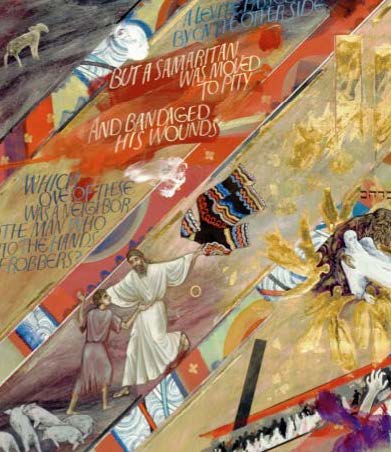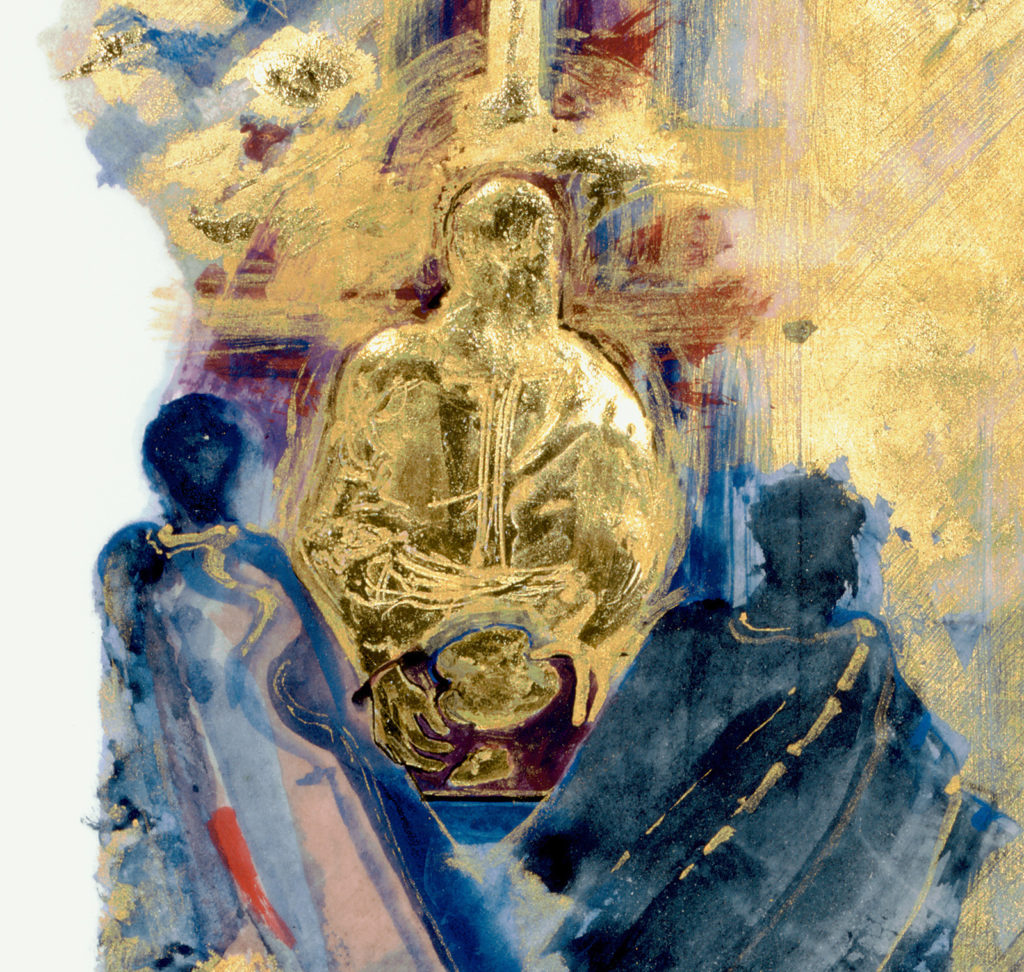George Fox University celebrates its 125th anniversary with on-campus events, presentations around the country, and the publication of over a dozen essays on Saint John’s Bible-related themes.
Honoring its Christian Mission With The Saint John’s Bible
George Fox University opened its doors in 1891, following the establishment of Pacific Friends Academy four years earlier. The school was drawn together by Dr. Henry John Minthorn for the educational benefit of—among others—a young Herbert Hoover, who had moved to Newberg, Oregon, from West Branch, Iowa where his parents had died before he was eleven. Hoover was part of the Academy’s first graduating class, but upon commencement, he’d fixed his eye on a competing start-up college with an engineering program, Stanford. Our engineering program was established twenty years ago.
In celebrating the 100th anniversary of George Fox College (University since 1996), the Centennial Clock Tower designed by world-renowned architect Pietro Belluschi was built, rising 65 feet in the center of the Quad. Its carillon bells ring on the quarter-hour (though not at night or Saturday mornings—for which students are thankful), and its image has become central to the University’s logo in recent years.
In celebration of its 125th anniversary, the University began the process of acquiring the Heritage Edition of The Saint John’s Bible. The acquisition was completed in January 2020.
Whereas the Centennial Clock Tower also houses the Victory Bell (rung after each athletic victory), The Saint John’s Bible furthers the University’s longtime biblical and Christ-centered mission—featuring the illuminative power of the inspired Word of God. And that’s an exciting prospect!
Initiatives to Introduce the Heritage Edition On-Campus and Beyond
Our engagement with Saint John’s University began with A Year With The Saint John’s Bible, a program that included several initiatives. First, we held a Turning of the Page event in the library every Friday afternoon at 4 p.m. and kept those pages on display throughout the week. This piqued interest leading up to the Friday events. We also joined in with Pope Francis’ “Mission of Love” in the fall of 2015, featuring the reading of biblical texts at noon and showing off the artwork illuminating the meaning of each of those seven texts.
To engage the community, we scheduled presentations on campus, in churches and at other universities. Part of my goal was to feature the illuminative artwork of The Saint John’s Bible, expanding upon such themes as its social conscience and the biblical featuring of women, along with justice and spirituality themes. Some of these presentations were designed in celebration of Advent and Christmas and Holy Week and Easter. I also invited fellow art professors and biblical scholars to participate in some of these presentations. Lectures delivered at Malone and Azusa Pacific Universities advanced the featuring of their acquired Heritage Editions, and a presentation at Chapman University supported their interest in moving toward their acquisition of the seven-volume limited edition. I served as Chapman’s Griset Chair in Bible and Christian Tradition during the spring semester of 2017.

Illuminating the Online Community
My work with The Saint John’s Bible continued through a number of published articles. On my Huffington Post site, for instance, I posted a dozen essays on such themes as “The Creation of the Cosmos,” “God’s Promises to Abraham…and the World,” “Commandments of Love,” “The Healing of the World,” “The Feeding of the Multitudes,” and “The Outpouring of the Holy Spirit.”[1] In addition to these essays supporting the visit of Pope Francis to America, three other essays featured the Social Conscience of The Saint John’s Bible— “The Invitation to Forgive, Today and Always,” “On Syrian Refugees and the Reversals of Christmas,” and “Ethiopian Lives Matter.”
The first of these essays was posted a few days after 9/11/2015, and Krista Tippett featured it on her OnBeing website.[2] It focused on Donald Jackson’s inclusion of two gold-embossed Twin Towers in his “Luke Anthology” masterpiece. Wow! If the whole point of the Prodigal Son parable in Luke 15 is forgiveness, the subtle adding of Twin Towers invites us to put forgiveness into play, even when it might be the most difficult to imagine.
We are thus reminded that the Bible is not a safe book. It challenges, provokes and confronts as well as comforting, instructing and inspiring its readers—and now, its viewers. Revisions of these essays were then gathered into a larger essay published in the first volume of collected essays on the illuminative artwork of The Saint John’s Bible.[3]
One final example comes to mind in reflecting upon the powerful artwork of The Saint John’s Bible. When viewing the two illuminated images at the end of Luke featuring Jesus on the cross and Jesus appearing to his disciples on the road to Emmaus, the face of Christ is clearer in the latter image. Thus, in the post-resurrection experience, we might glimpse the face of Christ even more fully in the breaking of bread than gazing at historical representations, helpful as they may be.

Such is the insight of Donald Jackson’s interpretive artwork, and such is the illuminative thrust of The Saint John’s Bible, as we look forward to our next 125 years at George Fox University.
[1] These and other essays are accessible on this site: https://www.huffpost.com/author/panderso-792.
[2] Thanks to Krista Tippett and Marie Sambiley for featuring this essay on the OnBeing site: https://onbeing.org/blog/illuminating-the-social-conscience-of-the-bibles-challenge-to-forgive/.
[3] Paul N. Anderson, “The Social Conscience of The Saint John’s Bible.” The Saint John’s Bible and its Tradition: Illuminating Beauty in the Twenty-First Century. Jack R. Baker, Jeffrey Bilbro, and Daniel Train, editors (Eugene: Pickwick Press, 2018), 136-54.
Paul N. Anderson is Professor of Biblical and Quaker Studies at George Fox University, where he has served since 1989. Author of over 250 published essays and author or editor of 30 books, his From Crisis to Christ offers a contextual introduction to the New Testament, and his Following Jesus offers a practical approach to Christian discipleship. His Riddles of the Fourth Gospel offers an inductive introduction to the Gospel of John.

